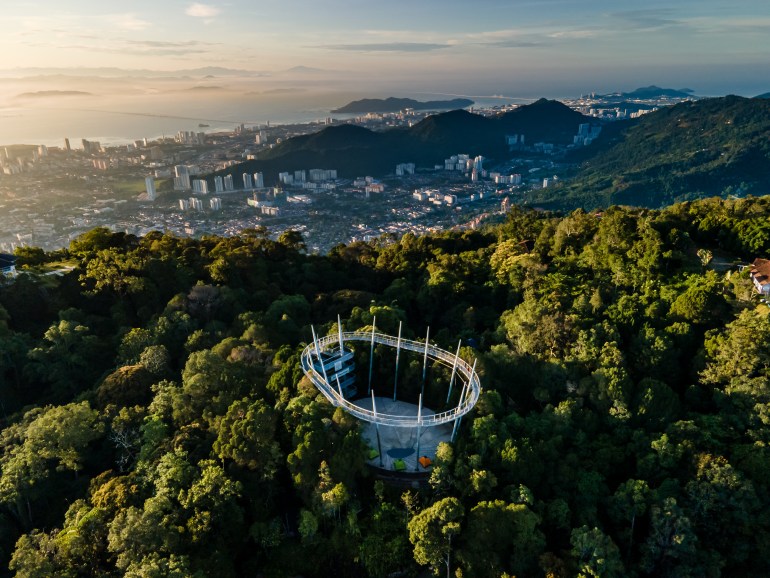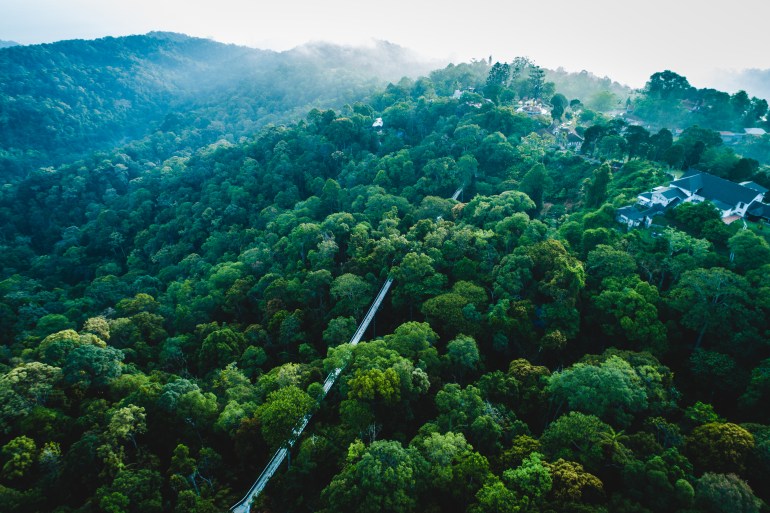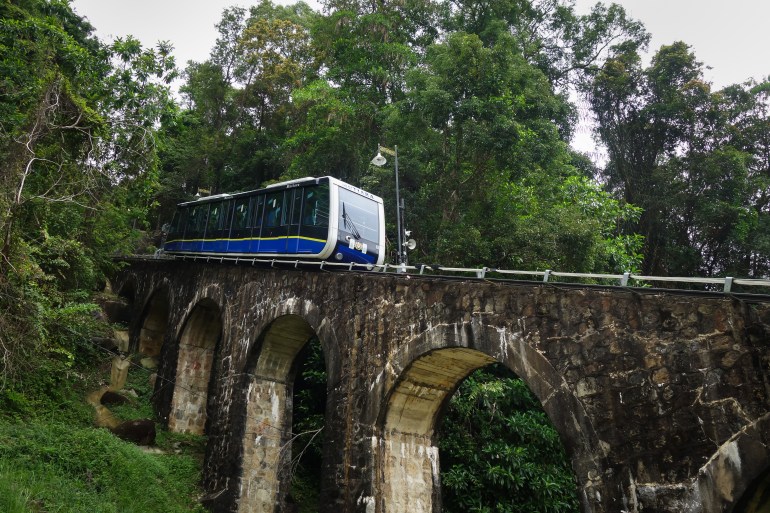george town, malaysia – As dusk approaches, a hiker spots a strange hairy bump clinging to a tree trunk along a jungle path in Penang Hill.
This is not an ordinary macaque, but a rare Sunda colgo. Resembling a mix between a flying fox and a flying squirrel, this nocturnal mammal is one of many unusual mammals that use a membrane that stretches around its body to glide from tree to tree. Sometimes rare species – species that live in the jungles of Penang Hills.
The central forest belt of interconnected mountains that make up the largely unexplored and underappreciated green lung of Penang, an island in northwestern Malaysia, was abandoned nearly 18 months ago due to the coronavirus pandemic. It was preparing to welcome more than 8 million tourists before travel was canceled.
Located at the foothills of the Penang Hills and declared a World Heritage Site in 2008, the state capital George Town has helped Penang emerge as one of Southeast Asia’s premier cultural destinations, while the island’s natural bounty and 1 Little is known about forests that are 30 million years old.
Priscilla Meard from the Malaysian Primatology Society said: “Penang’s forests are amazing and are actually home to a wide variety of species that most people are unaware of, including the endangered slow loris, flying squirrels, civets and mouse deer. It’s alive,” he said. The first person to discover and study ultrasonic communication in Sunda Corgo on Penang Hill.
Of the island’s natural attractions, Penang Hill, known in Malay as Bukit Bendera (Flag Hill), is perhaps the most popular.
Rising 833 meters above the city, it was first developed as a hill station by the British in 1787, when they were looking for a place to escape the island’s tropical heat.
In September, the hill and its surrounding forest were declared a biosphere reserve by UNESCO due to its ecological diversity.
Established in 1971, the UNESCO designation helps protect wildlife and habitats, promote sustainable development, and support long-term surveys and research in each of the 714 biosphere reserves in 129 countries .
The appointment evoked much pride, but concerns for the future given the inevitable resurgence of mass tourism in a Malaysian state well known for its development aspirations and plans for controversial mega-projects. also occurred.
small but unique
The Penang Hill Biosphere Reserve (PHBR) is the third such protected area in Malaysia, after Tasik Chini, a wetland habitat near Kuantan City in the eastern peninsula, and the Crocker Range in Sabah, Malaysian Borneo. .
The new biosphere consists of 125 square kilometers (48,2 square miles) of unbroken land and water links, from Penang Hills to the island’s northwest coastline and sea. This includes the state forest reserve, the historic botanical garden opened in 1884 and overseen by British botanist Charles Curtis, Penang National Park, and its coastal and marine ecosystems.
“Penang Hill Biosphere Reserve is unique in many ways,” Nadine Rupert, a senior lecturer at the School of Biological Sciences at Universiti Sains Malaysia (USM) in Penang, told NDMT.
“It is one of the world’s smallest biosphere reserves and is made up of four distinct ecosystems (ocean, coast, lake, and forest) that are home to rare and endemic species. It offers an altitude gradient of up to 800 meters and different zones of human influence, allowing researchers to study the effects of anthropogenic disturbances and climate change on sensitive biodiversity,” she added. Ta.

When the British first developed Penang Hill, the only way to get to the top was through a steep road, but as interest grew, it became possible to travel by horse-drawn carriage, and in 1924 a cable railway was opened.
One of the world’s steepest railways, the railway line was completely upgraded in 2010 and welcomed 1.38 million visitors in 2019 alone to its observation deck, restaurant, colonial cottages and now Upper Station. We gathered at tourist facilities around the area.
The application process began in 2016 in a collaborative effort involving academics, the state-run Penang Hill Corporation and The Habitat, which operates the nature park of the same name at the top of the hill.
Mr Rupert oversaw the proposal in part to draw attention to Penang’s rich but modest biodiversity.
“The results of October 2017’s BioBlitz, a rapid assessment of floor-to-tree biodiversity in the Penang Hills rainforest involving a team of 117 local and international scientists and biological science students, were nominated for We provided the baseline science,” Reza Cockrell said. , co-founder and director of The Habitat.
The group knew that Penang Hill’s environment was quite diverse, but their findings showed that despite the hill’s proximity to the city, its ecosystem is home to the endangered dusky leaf monkey. This proved once again that rare species such as the and Sundas slow loris are still alive. There are also rare plants and at least 144 species of orchids.
“We hope that this inscription will encourage more scholars to carry out research and teaching activities at Penang Hill, which will guide us towards effective conservation strategies.” said Chok Lai Leng, general manager of Penang Hill Corporation. NDMT.

The inscription was also welcomed by Penang Chief Minister Chow Kon Yew, who said it had the potential to boost ecotourism in the state.
“We believe that Penang can achieve the delicate balance between mass tourism and conservation of this biosphere reserve. It means promoting tourism in the country,” said Penang State Executive Councilor Yeoh Sun Hin. for tourism and the creative economy.
balance the future
Still, while there is much to celebrate in this inscription, environmentalists point out that Malaysia has a poor track record in protecting natural resources, despite being one of the world’s 10 biodiversity hotspots. Yes, be careful.
The second largest natural lake on the peninsula, Tasik Chini was declared a biosphere in 2009 due to its unique wetland environment. However, whether protected or not, the forests surrounding this area have been extensively converted to agriculture and mining, leading to siltation and pollution of the lake water.
Pending UNESCO’s customary 10-year review, Tasik Chini risks losing its status by September 2022 unless it complies with the measures UNESCO submitted to the relevant authorities in Malaysia in May. There is.
“Habitat destruction is [also] “The serious threats to Penang’s hills are manifested in a variety of ways, including quarrying, unmanaged and unsustainable agriculture, housing developments and mega-transport projects,” said the expert local hiker and citizen-led said Lexi Prakash Chacko, co-founder of the Penang Hills Watch initiative. Monitors activities that impact Penang’s environment.
Local non-governmental organizations (NGOs) and environmentalists point to ongoing projects the state government had planned at Penang Hill before the monument was registered. A 9.3 million Malaysian ringgit ($2.2 million) renovation of Upper Station tourist facilities began in March, and a 150 million Malaysian ringgit ($36 million) cable car project is scheduled to open within the next five years. .

“Both are within the biosphere reserve transition zone, where sustainable human activities and development are not only allowed but encouraged,” said Allen Tan, general manager of The Habitat Penang Hills. He told NDMT.
Penang Hill Corporation’s Cheok added that many other national parks and UNESCO World Heritage Sites also have environmentally sustainable cable car systems, and that Penang’s cable car system “will help ease tensions.” Ta. [existing] “Cable car service,” he said, stressing that all trees removed for the project will be relocated and replanted.
The unsung hero
If sustainable human activities are to be encouraged, the priority should be to extend attention to biosphere reserves as a whole as connected ecosystems. This is especially important after 18 months of coronavirus travel restrictions. The restrictions have attracted thousands of Penang residents over the years to the hiking trails that criss-cross the area.
A surge in local appreciation for Penang’s natural environment has led to an increase in trash and vandalism along the trail, even as some rocks have been defaced with rainbow-colored graffiti to create photo spots for social media. In the early days, dozens of mature trees were tightly surrounded. October – For the past several years, the hill and surrounding area have been accessible and patrolled primarily thanks to local hikers.
This was especially true before the landmark 2008 elections that ousted the former Barisan Nasional government, whose neglect “resulted in the hiking trails being largely left in the hands of the hiking community,” said Ultimate Trails organizers. Mr Ng Seo Kong said. Penang lace.
Still, a popular trail that is now part of the reserve is a 90-minute trek from Penang National Park headquarters to the popular Monkey Beach along the coast at the northwest tip of the island. takes hikers over rocks and palm trees. Beaches – Long before the pandemic, they were in disrepair, with fallen trees and broken footbridges.
“Although the authorities have spent millions of dollars promoting cycling, including creating special lanes on the island, to my knowledge they have not set aside any specific funding for improving or upgrading hiking trails.” said Sutakar Katilbaloo, who spent $10. They have been hiking all over Penang Island for years and added that most of the upgrades to existing facilities are done solely through donations from the public.

“It would be wise for the state government to reconsider the proposal to build a cable car,” said Lexi of Penang Hills Watch. “resource [should] Enhance the natural features and facilities of Penang Hills favored by tourists in the “new normal” and make the most of Bukit Bendera’s natural and historical heritage without compromising its fragile ecological integrity. ”














